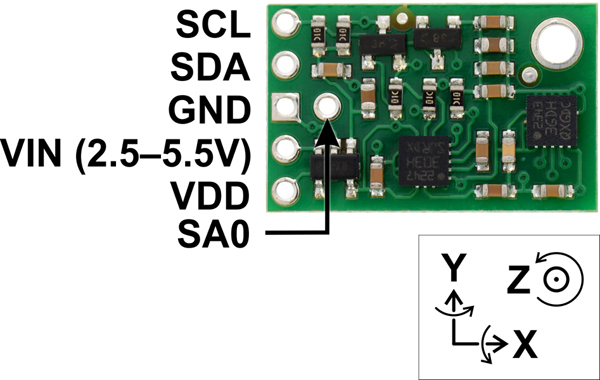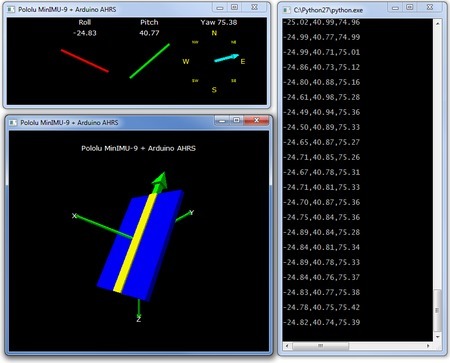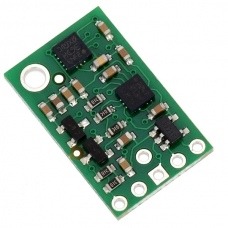MinIMU-9 v3 Gyro, Accelerometer, and Compass (L3GD20H and LSM303D Carrier)
The Pololu MinIMU-9 v3 is a compact (0.8″ × 0.5″) board that combines ST’s L3GD20H 3-axis gyroscope and LSM303D 3-axis accelerometer and 3-axis magnetometer to form an inertial measurement unit (IMU); we therefore recommend careful reading of the L3GD20H and LSM303D before using this product. These sensors are great ICs, but their small packages make them difficult for the typical student or hobbyist to use. They also operate at voltages below 3.6 V, which can make interfacing difficult for microcontrollers operating at 5 V. The MinIMU-9 v3 addresses these issues by incorporating additional electronics, including a voltage regulator and a level-shifting circuit, while keeping the overall size as compact as possible. The board ships fully populated with its SMD components, including the L3GD20H and LSM303D, as shown in the product picture.

Compared to the previous MinIMU-9 v2, the v3 version offers a number of improvements arising from the use of newer MEMS sensors, including a wider maximum magnetic sensing range and better gyroscopic accuracy and stability. This version also adds a pin for changing the sensor slave addresses, allowing two MinIMUs to be on the same I²C bus. The MinIMU-9 v3 is pin-compatible with the MinIMU-9 v2, but changes in I²C addresses and configuration registers might require some changes to software written for older versions (this should not be an issue if you are using our Arduino libraries).
The L3GD20H and LSM303D have many configurable options, including dynamically selectable sensitivities for the gyro, accelerometer, and magnetometer. Each sensor also has a choice of output data rates. The two ICs can be accessed through a shared I²C/TWI interface, allowing the sensors to be addressed individually via a single clock line and a single data line. Additionally, the SA0 pin is accessible, allowing users to change the slave addresses and have two MinIMUs connected on the same I²C bus (For additional information, see the I²C Communication section below).
The nine independent rotation, acceleration, and magnetic readings (sometimes called 9DOF) provide all the data needed to make an attitude and heading reference system (AHRS). With an appropriate algorithm, a microcontroller or computer can use the data to calculate the orientation of the MinIMU board. The gyro can be used to very accurately track rotation on a short timescale, while the accelerometer and compass can help compensate for gyro drift over time by providing an absolute frame of reference. The respective axes of the two chips are aligned on the board to facilitate these sensor fusion calculations. (For an example of such a system using an Arduino, see the picture below and the Sample Code section at the bottom of this page.)

Visualization of AHRS orientation calculated from MinIMU-9 readings.
The carrier board includes a low-dropout linear voltage regulator that provides the 3.3 V required by the L3GD20H and LSM303D, allowing the module to be powered from a single 2.5 V to 5.5 V supply. The regulator output is available on the VDD pin and can supply almost 150 mA to external devices. The breakout board also includes a circuit that shifts the I²C clock and data lines to the same logic voltage level as the supplied VIN, making it simple to interface the board with 5 V systems. The board’s 0.1″ pin spacing makes it easy to use with standard solderless breadboards and 0.1″ perfboards.
Specifications
- Dimensions: 0.8″ × 0.5″ × 0.1″ (20 mm × 13 mm × 3 mm)
- Weight without header pins: 0.7 g (0.02 oz)
- Operating voltage: 2.5 V to 5.5 V
- Supply current: 6 mA
-
Output format (I²C):
- Gyro: one 16-bit reading per axis
- Accelerometer: one 16-bit reading per axis
- Magnetometer: one 16-bit reading per axis
-
Sensitivity range:
- Gyro: ±245, ±500, or ±2000°/s
- Accelerometer: ±2, ±4, ±6, ±8, or ±16 g
- Magnetometer: ±2, ±4, ±8, or ±12 gauss
Download:
Write a review
Your Name:Your Review: Note: HTML is not translated!
Rating: Bad Good
Enter the code in the box below:





